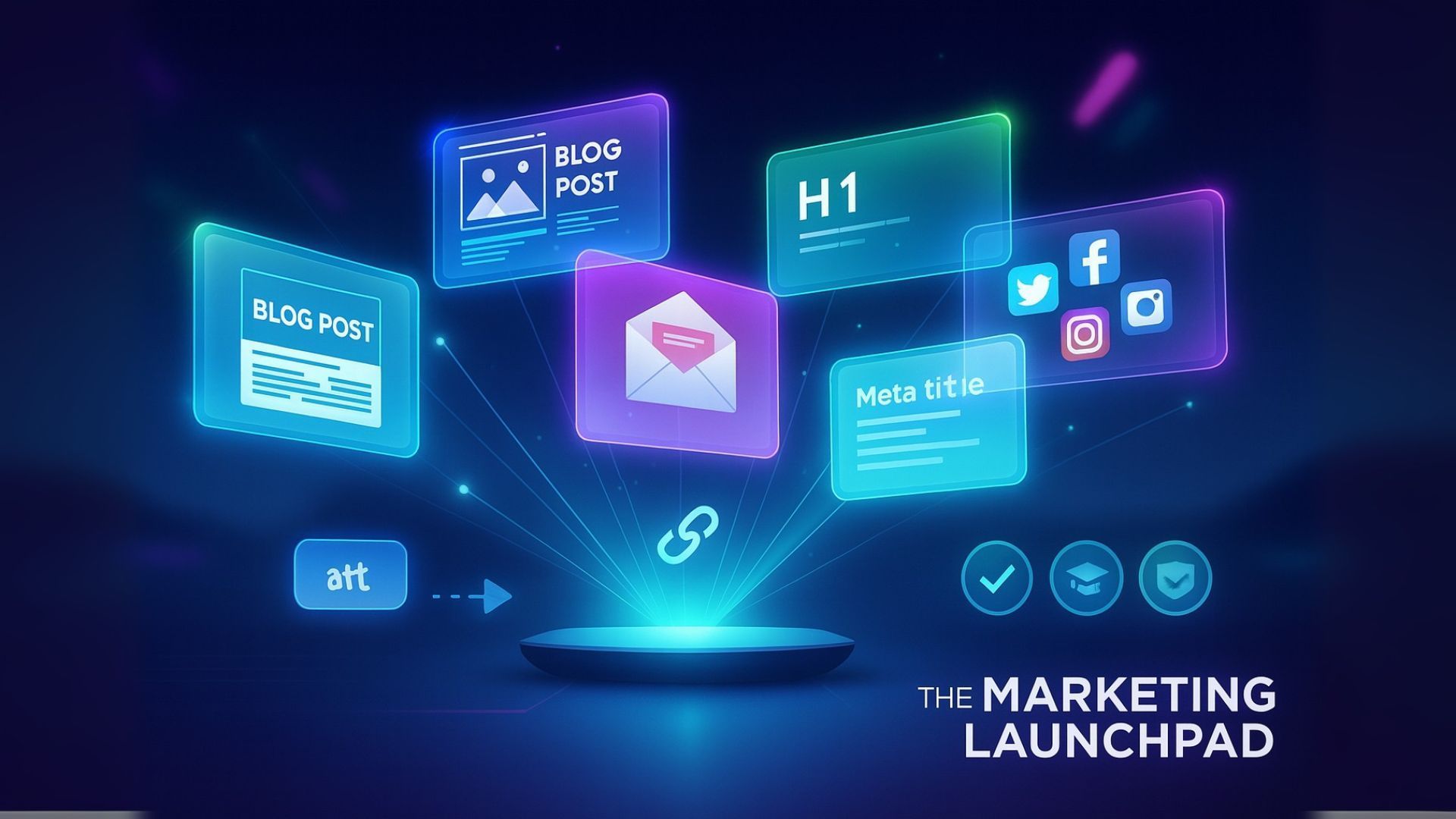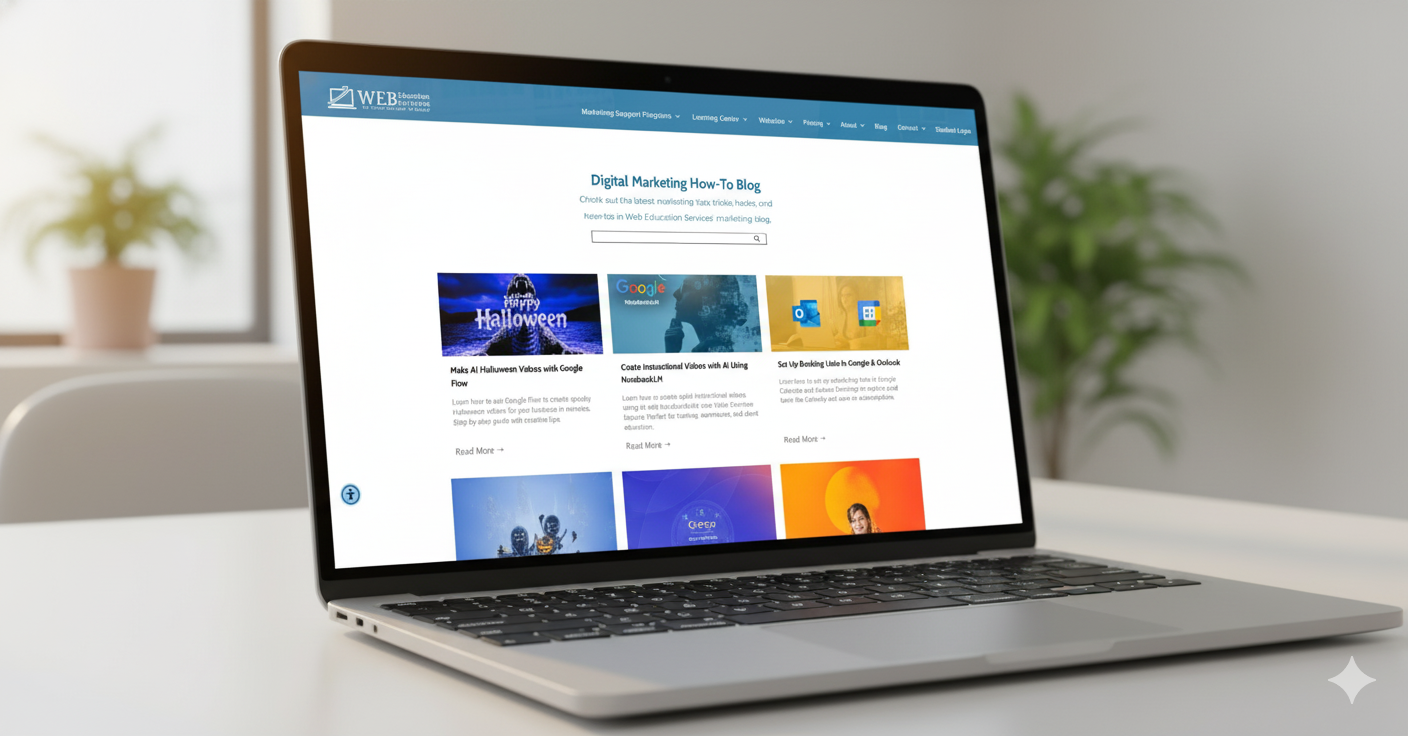Learn how to turn blogs into leads with ad, email, social, and Performance Max copy using Marketing Launchpad prompts.

The real problem: publishing is “easy”… until you actually do it
You have a folder full of assets—great images, a solid video clip, and copy you’re proud of. Then you open your CMS and run straight into friction. Should that subhead be an H2 or an H3? Where does the video go so it won’t slow the page to a crawl? What belongs in alt text? How short is “short enough” for a meta description? And once you hit publish, how do you turn all that work into pipeline?
Underneath these micro-questions is one big theme: a blog post isn’t a text dump—it’s a structured, intentional piece of marketing. When the structure is clear, the media supports the story, and the SEO details are handled, your post gets found and moves readers to act. When those pieces are fuzzy, even great content underperforms.
This article gives you a repeatable way to assemble images, videos, and copy into a Yoast-friendly, commercial-intent post that looks great, loads quickly, and converts. You’ll find a balance of narrative advice and short lists you can scan—so you can get this into your workflow today.
Why blog structure matters (for readers, rankings, and revenue)
A well-structured blog solves three problems at once: it helps people scan, it helps search engines understand, and it helps buyers decide. In other words, structure isn’t a cosmetic choice; it’s how your post earns attention and trust.
Think of the page as a guided path. The introduction names the problem or focus. Each H2 covers a subtopic that your audience actively cares about. H3s break down steps, examples, or FAQs. Images and videos sit next to the paragraph they reinforce—not piled at the top or bottom. And your call to action shows up at the moment interest peaks, not as an afterthought.
A practical, reusable layout:
- H1 (one per page): Clear promise using natural language.
- Lead paragraph: Name the problem your reader is wrestling with.
- H2 sections: Each covers one key concept the reader wants to evaluate.
- H3s where needed: Steps, examples, mini-FAQs.
- Media placement: Put visuals where they add clarity, not just decoration.
- CTA block: Contextual, specific, and easy to act on.
- Internal links: Move readers (and crawlers) to your related resources.
The reason this works is simple: the structure mirrors how people think when they’re evaluating a solution. It meets them where they are and makes the next step obvious.
Write to search intent (and choose a primary intent on purpose)
Search intent is the “why” behind a query. If your content satisfies that “why,” you win the click and keep the reader. If you ignore it, your bounce rate tells the story.
The five core intent types you should recognize:
Informational intent.
The reader wants to learn. They’re asking “how to compress images for web” or “what is alt text.” These posts should define terms, teach steps, and end with a soft next step—like a template or guide.
Navigational intent.
They’re trying to reach a trusted destination (“Web Education Ser
vices workshops,” “Yoast readability”). Your job is to confirm they’re in the right place and offer quick paths.
Commercial (evaluation) intent.
They’re comparing options (“best blogging CMS for SEO,” “WordPress vs Duda speed”). Use short comparisons, checklists, and proof points. Offer a workshop, demo, or consultation as the logical next step.
Transactional intent.
They’re ready to act (“sign up blogging workshop,” “book content audit”). Keep copy concise, clarify value, reduce friction, and make the next step unmistakable.
Local intent.
They want a solution near them (“blog training near me,” “Tampa SEO workshop”). Include service areas, maps, hours, and local proof.
For this article, the primary intent is Commercial: you’re evaluating how to systematize publishing and whether to do it yourself or work with a team. Everything below supports that decision.
E-E-A-T: the trust frame that powers high-performing posts
Google’s quality lens—Experience, Expertise, Authoritativeness, and Trustworthiness—isn’t abstract check-boxing. It’s the shortest path to content that convinces real people.
Experience (show you’ve actually done this).
Share first-hand details. Mention the compression target you aim for (e.g., “we keep most inline images under ~120 KB”), the hosting choice you prefer for embeds, or the way you name files. Screenshots and quick GIFs go a long way.
Expertise (prove depth, not just breadth).
Explain the “why” behind your choices—why WebP beats PNG in most cases, why you embed a video below the section that teed it up, why you reserve width and height to prevent layout shift. Practical nuance signals you know your craft.
Authoritativeness (signal reputation).
Publish under a named author with a brief bio. Link to your pillar resources and case snapshots. Cross-reference materials that expand the topic, such as your internal playbooks and workshops.
Trustworthiness (reduce perceived risk).
Keep pages fast (lazy-load, compress, cache), secure (HTTPS, no sketchy scripts), and accessible (sensible heading order, alt text, captions). Add a last-updated date for process posts. And keep your CTA honest—no bait and switch.
A good shortcut: if a skeptical buyer asked “How do I know you actually do this?”, your post should answer that with specific, first-hand detail.
Internal and external linking that guides readers (and crawlers)
Links are the paths through your content. Used well, they create momentum and context.
Start with a simple topic cluster model: one pillar page that covers the core topic at a high level, and several supporting posts that go deep on specific angles. Each supporting post links to the pillar; the pillar links back to the supporting posts. This builds semantic clarity for search engines and a frictionless journey for readers.
Use internal links to:
- Lead readers deeper at the moment curiosity spikes.
- Provide definitions or proofs without derailing the main story.
- Concentrate topical authority on your pillar content.
Use external links to:
- Add credibility with one or two well-chosen references.
- Help readers confirm a claim (without sending them to competitors).
- Earn trust by showing you’re plugged into respected sources.
Descriptive anchor text matters. “Blog structure checklist” beats “click here.” And place links near the paragraph they support—don’t bury them at the end where they’re disconnected from the moment of interest.
For this topic, logical internal links include Marketing Launchpad (/marketing-launchpad) for a repeatable system, Blog Strategy Guide (/blog/blog-strategy-guide) for planning, and Weekly Workshops (/workshops) for live help. As an external reference for readability guidance, Yoast’s readability guidance (https://yoast.com/readability/) is a strong, non-competitive source.
On-page SEO essentials: titles, descriptions, alt text, and structure
On-page SEO isn’t about tricks; it’s about clarity and consistency. If a human can scan your page and know what it’s about—and a crawler can parse the same signals—you’re most of the way there.
Meta title (≤ 55 characters).
Lead with the promise and your primary keyword. Avoid shouting and stuffing. Small differentiators (“Fast,” “Template,” “Checklist,” “2025”) can improve click-through.
Meta description (≤ 145 characters).
Extend the promise and invite the click. Use natural language and a soft CTA.
URL slug.
Keep it short, readable, and hyphenated. Include the primary keyword once. Example:
/post-images-videos-copy-blog
.
Headings (H1–H3).
One H1 only. H2s define the main sections; H3s subdivide steps, examples, or FAQs. Write subheads so a skimmer can understand the page without reading every sentence.
Image alt attributes.
Write for accessibility first, context second. Six to twelve words is plenty. Describe the function, not every pixel: “Example of H2 and H3 hierarchy in a CMS editor.”
Media performance.
Serve most photos/graphics as WebP, reserve PNG for transparent overlays, SVG for icons/logos. Keep hero images lean (ideally <200 KB) and inline images lighter. Lazy-load below-the-fold media and reserve dimensions to prevent layout shift.
Video handling.
Host offsite (YouTube, Vimeo, or privacy-friendly hosts), add captions or a short transcript, and embed after you’ve teed up why it matters. Upload a custom thumbnail that looks consistent with your brand.
Schema (optional, recommended).
Article schema for posts; FAQ schema if you include Q&As. Organization schema site-wide.
Accessibility and UX.
Readable typography (≥16px with 1.5 line height), strong color contrast, and visible focus states for links and buttons.
When you handle these elements consistently, you compound gains: better CTR from SERPs, better dwell time from readers, and better conversion from motivated buyers.
A practical, step-by-step publishing workflow
Here’s a workflow you can adopt as is. It emphasizes speed without sacrificing quality.
- Choose the primary intent.
Decide what the reader came to accomplish. For this post, it’s Commercial—evaluation leading to action. - Outline before drafting.
List H2s (major points) and any H3s (steps or examples). This makes writing faster and keeps the page scannable. - Prep your media.
Export images as JPG with descriptive filenames, and gather video links and captions. Match each visual to a specific paragraph. - Write a clear lead.
Name the problem and promise in two to three sentences. Keep it human. - Draft the body in short paragraphs.
Active voice, varied sentence lengths, and transitions to maintain flow. If a paragraph runs long, split it. - Place internal links where curiosity peaks.
Link to your pillar page and two related resources. Use descriptive anchors. - Add one authoritative external link.
Choose a non-competitive source that strengthens your point (e.g., Yoast for readability). - Embed media adjacent to the relevant copy.
Don’t stack everything at the top or bury it at the end. - Write your meta fields and slug.
Keep the title and description within length guidelines and reflect the page promise. - Quality pass for E-E-A-T and accessibility.
Check for first-hand notes, author bio, last-updated date, and sensible alt text. - Publish and distribute.
Send a teaser email, schedule two to three social snippets, and repurpose a 20–30-second video clip that previews the post. - Review performance.
Watch time on page, scroll depth, CTA clicks, and conversions. Adjust internal links or CTA placement if people stall.
This process becomes much faster once you’ve done it a few times. If you want a done-with-you setup, our Marketing Launchpad (/marketing-launchpad) standardizes these steps so publishing takes hours—not days.
From post to pipeline: make the next step irresistible
A blog that ranks but doesn’t convert is unfinished work. To make commercial intent pay off, connect your education to an obvious outcome.
- Start with
contextual CTAs.
If you just walked readers through a posting workflow, offer a live workshop where you implement the template together. Put the CTA near your strongest proof point, not only at the end.
- Layer in
proof snippets.
Short wins build confidence: “Teams using this checklist cut publish time by 35%,” or “This structure lifted workshop sign-ups by 22%.” You don’t need a full case study in every post; one or two crisp facts work.
- Create
lead assets that match the moment.
A one-page “Publishing Readiness Checklist,” a simple image-compression cheat sheet, or an outline template converts scanners into subscribers.
- Use
next-step pages instead of homepages.
Readers who are evaluating a workflow shouldn’t be sent back to your homepage. Deep link to your workshop page, your system overview, or your relevant service. - Finally, build a
distribution habit.
Treat publishing as the start of the campaign, not the end. A teaser email, a LinkedIn post with a key insight, a short video showing where to place a video embed in your CMS—these small touches dramatically expand reach.
A mini template you can adapt (no HTML required)
H2: Why Structure Turns Posts Into Pipeline
Open with a short paragraph about scanning, rankings, and decisions. Add a second paragraph that previews the specific structure you’ll use in the post.
H2: Write to Intent—Not Just Keywords
Explain your primary intent choice. Share one example query that signals that intent. Offer one sentence that ties the intent to your CTA.
H2: Build E-E-A-T Into the Post
One paragraph each on Experience, Expertise, Authoritativeness, and Trust. Include a single concrete detail that proves you do this in practice.
H2: Links That Guide, Not Distract
Write two paragraphs on internal linking (pillar page + cluster) and one on external linking (one strong source). Include one internal link right in this section and tell readers why you chose it.
H2: On-Page SEO Basics to Repeat Every Time
Close with one paragraph on meta title and description, one on headings and alt text, and one on media performance. End with a sentence that bridges to your CTA.
If you plug your own examples into that outline, you’ll publish faster and with more consistency—exactly what search engines and buyers reward.
FAQs (quick clarity wins)
Should I put the video at the top of the post?
Usually not. Tease it first so readers know why it matters, then embed after the section that sets it up. This keeps load time in check and increases watch rate.
How long should a commercial-intent post be?
Long enough to fully satisfy the evaluation. For most teams, 1,200–2,200 words works—provided the page is scannable and the CTA is clear.
Can I reuse the same meta description across posts?
Avoid it. Each page deserves a unique description that reflects its specific promise.
What’s a good file size for images?
Aim to keep hero images under ~200 KB and inline graphics between ~40–120 KB when possible, served as WebP. Always reserve width and height to prevent layout shift.
Wrap-up
When you bring structure, intent, and trust together, your images, videos, and copy stop being “assets in a folder” and start becoming assets that sell. The workflow above keeps you focused on what matters: clear sections, purposeful media, consistent SEO details, and a CTA that fits the moment.
If you want a repeatable system that bakes all of this into your process, explore Marketing Launchpad (/marketing-launchpad) and Blog Strategy Guide (/blog/blog-strategy-guide), or hop into our Weekly Workshops (/workshops) to set it up together in real time.
Join Our Workshop
👉 Ready to learn how it works? Join our weekly workshop and see how you can turn every blog post into a lead-generating machine.
Sign Up Here →
WebEducationServices.com/Sign-Up







